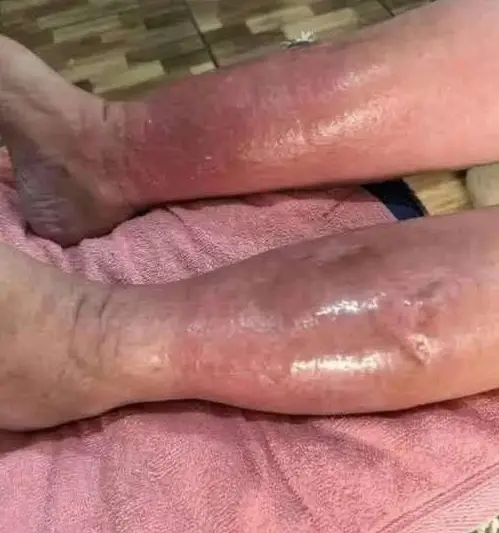
For a long time, I struggled with severe swelling in my ankles, feet, and legs—what doctors call pitting edema. So bad, in fact, that pressing into my ankle would leave a visible dent that lingered. What made it all the more confusing was that I wasn’t elderly, nor was I on any medications. Something was seriously wrong, but I didn’t understand what at the time.
Looking back at old photos, I noticed my face appeared round and bloated. At the time, I thought it was just a cosmetic issue. I didn’t realize then that a puffy, swollen face can often signal deeper problems related to blood sugar regulation. For me, these blood sugar issues were the root cause of the chronic swelling I experienced.
If you’re dealing with persistent swelling in your lower legs, ankles, or feet—known medically as edema—don’t panic. You may have been told it’s caused by kidney, heart, or liver problems, or that it’s due to eating too much salt. While those factors can contribute, I discovered a far more common and easily fixable cause. Here’s what I learned, and how I reversed my swelling safely, naturally, and without medications.
What Is Edema?
Edema is swelling caused by excess fluid trapped in your body’s tissues, often appearing in the lower legs, feet, and ankles. It can cause tightness, heaviness, and sometimes pain. In severe cases, pressing on swollen areas leaves a lasting dent in the skin—this is called pitting edema.
Common causes listed by doctors include:
Heart failure
Kidney dysfunction
Liver disease
Excess sodium intake
Certain medications
But there’s another key cause that often gets overlooked: cellular fluid regulation failure.
The Real Problem: When Your Cellular Pumps Stop Working
Inside every cell in your body, tiny mechanisms called sodium-potassium pumps control fluid balance. These pumps actively push sodium out of the cells and pull potassium in, maintaining the right fluid levels inside and outside the cells.
When these pumps fail, fluid leaks into the spaces between cells, causing swelling. Think of it like a basement sump pump failing in a house—water floods in and pools.
What causes these pumps to fail? The answer is excess sugar in the diet.
How High Blood Sugar Causes Swelling
When you consume refined carbs and sugars, your blood sugar spikes. This sugar attaches to proteins in your blood, including hemoglobin in red blood cells, through a process called glycation.
Glycation is essentially sugar molecules binding permanently to blood proteins, and it’s what the A1C blood test measures over three months.
Once proteins become glycated, they lose function, impairing blood circulation and nutrient delivery. This poor circulation leads to fluid pooling in your lower body, causing swelling. It also makes blood vessels “leaky,” allowing fluid to escape into surrounding tissues.
The more sugar you consume, the more glycation happens, which leads to:
Impaired oxygen and nutrient delivery
Fluid leakage and increased swelling
Nerve damage causing numbness, tingling, or burning sensations (especially in the feet)
Even if you aren’t diabetic but have borderline or prediabetic blood sugar levels, this process may already be harming your body.
The Three Key Nutrients That Help Repair Swelling
To reverse swelling, you need to repair the sodium-potassium pumps inside your cells. This requires three crucial nutrients:
1. Potassium
Potassium is vital for fluid balance and nerve function and is a main mineral used by the sodium-potassium pump. Most people don’t get enough—ideally, you need around 4,700 mg per day.
Good sources: avocados, leafy greens (spinach, kale), berries, sugar-free electrolyte powders
Avoid relying on bananas alone—they’re not enough and too sugary in large amounts.
2. Magnesium
Magnesium helps create ATP, the energy currency your cells need to power pumps. It also supports muscle relaxation and circulation.
Recommended intake: 400–420 mg/day
Good sources: pumpkin seeds, sunflower seeds, leafy greens, almonds, and quality supplements.
3. Vitamin B1 (Thiamine)
Vitamin B1 is critical for carbohydrate metabolism. Without it, sugar can’t be properly converted to energy, causing it to accumulate and promote glycation and swelling.
Eating sugar depletes your B1 levels, creating a vicious cycle of swelling and damage.
Good sources: nutritional yeast (unsweetened), sunflower seeds, beef liver, asparagus, and benfotiamine supplements (a highly absorbable form of B1).
The Solution That Worked for Me
Step 1: Cut Out Refined Carbs and Sugar
This means eliminating:
Soda, fruit juices
Bread, pasta, cereal
Candy, pastries
Processed snacks
As soon as I stopped eating these, my swelling started to decrease within days.
Step 2: Support Your Body with B1, Potassium, and Magnesium
I added:
Sugar-free electrolyte powders (for potassium and magnesium)
Daily nutritional yeast (for B1)
A benfotiamine supplement
Plenty of leafy greens, avocados, seeds, and berries
Within one week, the swelling in my ankles visibly reduced. After two weeks, the pitting edema disappeared. The numbness and tingling in my feet also faded.
Preventing Swelling Long-Term
If you revert to a high-sugar diet, swelling will likely return. The sodium-potassium pumps will break down again, and fluid will start pooling once more.
This isn’t about quick fixes or masking symptoms—it’s about understanding your body’s needs and supporting it with proper nutrition and lifestyle changes.
If you are struggling with swollen ankles, feet, or legs, consider looking beyond medications. Address the root causes with diet and nutrient support, and you may be surprised how much better you feel—just like I did.




